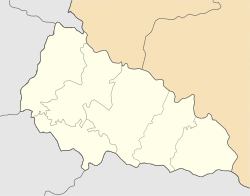Top Qs
Timeline
Chat
Perspective
Solotvyno
Rural locality in Zakarpattia Oblast, Ukraine From Wikipedia, the free encyclopedia
Remove ads
Solotvyno (also Solotvina; Ukrainian: Солотвино; Romanian: Slatina; Hungarian: Aknaszlatina or Faluszlatina; Rusyn: Солотвино; Yiddish: סעלאָטפֿינע, Selotfine; Slovak: Slatinské Doly) is a rural settlement in Tiachiv Raion in Zakarpattia Oblast of Ukraine, located adjacent to Romania, on the right bank of the Tisza River opposite the Romanian city of Sighetu Marmației. The current population is 8,391 (2022 estimate).[1]
Remove ads
History
Summarize
Perspective
Solotvyno was first mentioned c. 1360. The former town was burned down by the Tatars in 1241. In 1910, the town had a population of 2,330, the majority of whom were Hungarian. In 1920, with the collapse of the Austro-Hungarian empire, the town was divided in two, with the northern part of the right bank of the Tisza river becoming a part of the newly formed Czechoslovakia. The southern part became Sighet in Romania.[2]
In March 1939 the area was invaded and annexed by Hungary.[3] Almost the entire Jewish population was murdered in the Holocaust. In April 1944, Hungarian authorities established a ghetto in the Solotvino as part of the wider ghettoization of the region, confining Jews in overcrowded, unsanitary conditions that led to rampant starvation and disease.[4] On 25 May 1944, the remaining Jews of Solotvino were deported on a single train carrying 3,317 people to Auschwitz, where the majority were murdered in gas chambers on arrival.[5][6]
After World War II, Solotvino with the rest of Carpathian Ukraine became part of Ukraine in the Soviet Union. Under Soviet rule, Solotvyno's salt works were nationalized and integrated into the state-run Ukrsolprom, with extraction peaking at 451,000 tonnes per year in the 1970s, representing around 10% of Ukraine's total salt production. Speleotherapy, pioneered in Solotvyno during Soviet times, saw the 1968 founding of an experimental allergological hospital in Mine No. 8, with Mine No. 9’s underground chambers officially opened in 1976 to treat asthma and other respiratory diseases as a sanctioned USSR medical therapy.[7]
According to the 2001 Ukrainian Census, the majority of the population in the city is Romanian. In 2001, 56.97% of the 8,956 inhabitants spoke Romanian as their native language, while 14.54% spoke Ukrainian, 24.3% Hungarian, and 3.18% Russian.[8] Until 26 January 2024, Solotvyno was designated urban-type settlement. On this day, a new law entered into force which abolished this status, and Solotvyno became a rural settlement.[9]
Remove ads
Geography
The village is located in the eastern part of Zakarpattia Oblast, on the right bank of the Tisza River, between Rakhiv and the district center Tyachev. The district center Tiachiv is located 24 kilometers from Solotvino. The village's name comes from the nearby salt mine. [10][11]
The territory of the village has a flat relief. The climate is temperate continental with warm summers and mild winters. South-westerly winds prevail throughout the year. [12]
The Solotvino rock salt deposit is located near the village of Solotvino.[13][11]
The settlement is the final stop of the Ukrainian section of the railway, which runs from Lviv to Transcarpathia. [14][15]
Remove ads
Tourist attractions
The city has a salt mine museum, in the southwestern part of the village, with traces of ancient salt mines from Roman times, the Gortsy salt mine. There is an archaeological monument dating from the 9th century BC to 4th century AD, and the Kunigunda salt lake (salt concentration 146–150 ‰).[10]
Notable residents
- Robert Maxwell, British MP, business owner and fraudster (1923–1991), born here when the village was part of the First Czechoslovak Republic.[16][17]
Gallery
- A salt mine in the town of Solotvyno
- Recreation camp, "El dorado"
- Underground office of the hospital
- Former synagogue
- Former synagogue, now bakery
- Old Jewish cemetery
- New Jewish cemetery
- Jewish memorial plaque
References
External links
Wikiwand - on
Seamless Wikipedia browsing. On steroids.
Remove ads















